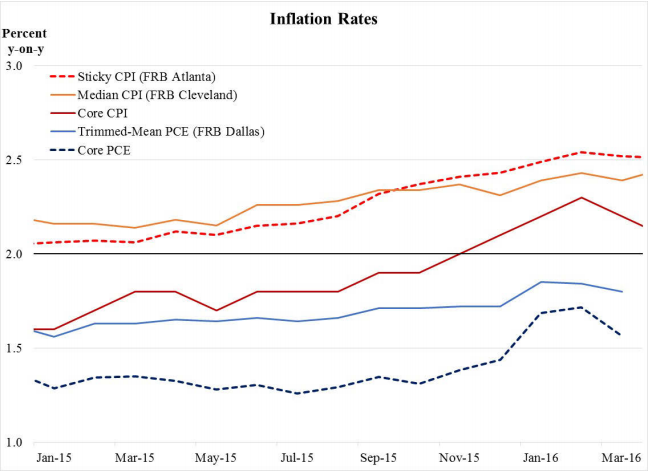Several Fed Presidents gave presentations this past week. All argued the U.S. economy was not only at or near full employment but also that prices were rising and would eventually attain the Fed’s 2% price target. This implied that a rate hike within the next few meetings was a foregone conclusion.
The 5% unemployment rate was sufficient reason for San Francisco President Williams to argue the economy attained full employment. Williams’ primary inflation concern was how to avoid overshooting the Fed’s 2% price target:
I wouldn’t want us to purposefully overshoot inflation—the 2 percent goal by a lot and for an extended period, and here’s why. If we overshoot inflation, inflation moved to 2 ½ or 3 percent, say, well, then we would have to bring inflation back down and we would have to tighten policy and slow the economy a lot. So I think that there are some risks. There are always risks to overshooting your target and risks to, you know, having to undo that. So, you know, my, you know, kind of perfect landing for the economy would really have inflation moving, you know, basically back to 2 percent. And then from that point, you know, it sometimes would be a little above, sometimes a little bit below, but averaging 2 (percent).
President Bullard relied on a broader range of statistics, citing:
- Job openings per available worker are at a cyclical low.
- Unemployment insurance claims relative to the size of the labor force are at a multi-decade low.
- Nonfarm payroll employment growth has been well above longer-run trends.
- The level of a labor market conditions index, which aggregates many measures of labor market performance into a single index, is well above historical averages.
As with his employment position, Bullard relied on a broad spectrum of inflation data to argue prices were nearing the Fed’s 2% target:

Philadelphia President Harker argued April’s weaker headline number (net establishment jobs creation of 160,000) was weather related. Using a series of “weather adjustments,” Harker’s staff determined the appropriate level of Aprils’ establishment job creation was 229,000. He also used the Dallas Fed’s 1.8% Trimmed Mean Inflation rate to argue prices were nearing the Fed’s target.
Using the same statistics (low unemployment and gradually rising prices) President Powell also agreed on the need to raise rates:
For the near term, my baseline expectation is that our economy will continue on its path of growth at around 2 percent. To confirm that expectation, it will be important to see a significant strengthening in growth in the second quarter after the apparent softness of the past two quarters. To support this growth narrative, I also expect the ongoing healing process in labor markets to continue, with strong job growth, further reductions in headline unemployment and other measures of slack, and increases in wage inflation. As the economy tightens, I expect that inflation will continue to move over time to the Committee's 2 percent objective.
If incoming data continue to support those expectations, I would see it as appropriate to continue to gradually raise the federal funds rate. Depending on the incoming data and the evolving risks, another rate increase may be appropriate fairly soon. Several factors suggest that the pace of rate increases should be gradual, including the asymmetry of risks at the zero lower bound, downside risks from weak global demand and geopolitical events, a lower long-run neutral federal funds rate, and the apparently elevated sensitivity of financial conditions to monetary policy. Uncertainty about the location of supply-side constraints provides another reason for gradualism.
And finally, we have Fed President Yellen, who now falls firmly in the rate hike camp:
Federal Reserve Chair Janet Yellen threw her support behind a growing consensus at the central bank in favor of another interest rate increase soon, while steering clear of specifying the timing of such a move.
“It’s appropriate -- and I’ve said this in the past -- for the Fed to gradually and cautiously increase our overnight interest rate over time,” Yellen said Friday during remarks at Harvard University in Cambridge, Massachusetts. “Probably in the coming months such a move would be appropriate.”
“The economy is continuing to improve,” she said in a discussion with Harvard economics professor Gregory Mankiw. She added that she expects “inflation will move up over the next couple of years to our 2 percent objective,” provided headwinds holding down price pressures, including energy prices and a stronger dollar, stabilize alongside an improving labor market.
I have to admit, I’m a bit surprised by Yellen’s hawkishness. But I think she’s now a bit more concerned about the Fed’s credibility with markets on the issue.
The conclusion from all the above comments is clear: a hawkish consensus now dominates the Fed, indicating a rate hike is more than likely at the next few meetings.
